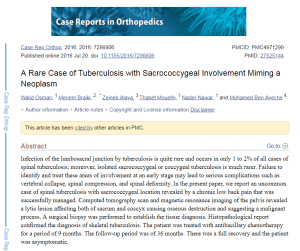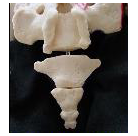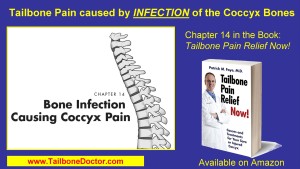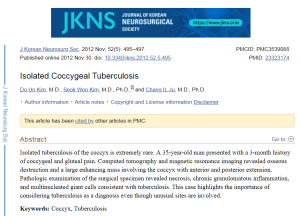What is Pott’s disease, or Pott disease?
- Pott’s disease is a condition where tuberculosis infection occurs within the spinal vertebral bones.
- “Pott’s disease” is also called “Pott disease.”
- Tuberculosis is commonly called “TB.”
Tuberculosis infection usually involves the lungs.
- Pott’s disease is different because the infection is within the vertebral bones of the spine.
Which spinal vertebral bones are usually infected in Pott’s Disease?
- In patients with Pott’s disease, usually the vertebral bodies infected with tuberculosis are the vertebral bones closest to the lungs, which are the vertebral bones of the thoracic spine. (These are the thoracic vertebral bodies.)
- However, other locations in the spine may also be affected. In rare cases, this may include tuberculosis of the coccyx (tailbone).
Below is an excerpt from Chapter 14 of the book Tailbone Pain Relief Now!
Tuberculosis (TB) Infection Causing Tailbone Pain
Tuberculosis (commonly referred to as TB) is a bacterial infection that typically involves the lungs. TB is more common in parts of Asia and Africa, as well as within certain populations in the United States, such as among prisoners.
Although TB typically starts as a lung infection, it can spread to the bones of the vertebral spine (called Pott’s disease). The vertebral bones most commonly infected are those of the thoracic spine, which are the spinal bones closest to the lungs. However, TB can instead spread to the spinal bones of the sacrum and coccyx.
Suspect possible TB infection of the coccyx region if you have a history of the following:
- pulmonary (lung) TB infection,
- a positive skin test (PPD test) for TB,
- travel to areas where TB is common, or
- an underlying condition that causes decreased ability of the immune system to fight infections.
The tuberculosis bacteria are often resistant to many antibiotics and thus treatment often requires giving multiple antibiotics to thepatient at the same time.
Here are some medical journal articles about Tuberculosis (TB) Infection Causing Tailbone Pain
- Kim, Do Un et al. “Isolated coccygeal tuberculosis” Journal of Korean Neurosurgical Society vol. 52,5 (2012): 495-7.
- Osman, Walid et al. “A Rare Case of Tuberculosis with Sacrococcygeal Involvement Miming a Neoplasm” Case reports in orthopedics vol. 2016 (2016): 7286806.
-

Tuberculosis with Sacrococcygeal Involvement Miming a Neoplasm, 2016 article in Case Reports in Orthopedics
Other TB thoughts from Dr. Foye:
- Lytic lesions: In the published medical literature, tuberculosis of the coccyx tends to be associated with “lytic” (destructive) appearance on imaging studies.
- A clinical impression of tuberculosis of the coccyx would usually be based upon a history of tuberculosis (or at least tuberculosis exposure), increased likelihood if there are imaging findings suggesting tuberculosis within other areas of the spine (although, rarely, the spinal tuberculosis might occur only at the coccyx in a more isolated way), failure to respond to typical treatments for coccydynia.
- Definitive diagnosis would usually require having a surgeon (or perhaps an infectious disease doctor, or interventional radiologists, or interventional musculoskeletal physician) place a needle into the site and obtain whatever fluid or tissue sample can be obtained, and then send that for special testing for tuberculosis. (This could include special cultures to look for acid fast bacilli, or even polymerase chain reaction [PCR] testing for Mycobacterium tuberculosis, etc.)
- Sputum tests: theoretically a positive sputum test would confirm TB in the lungs and thus make it more likely that a spine lesion might also be TB (and, conversely, a negative sputum test for TB would suggest that there is not TB in the lungs, and thus making it less likely that a spine lesion is from TB). Still, those would be about determining how likely or unlikely it is that there is spine/coccyx TB. Meanwhile, “definitive” diagnosis of a spine lesion is due to TB would generally require obtaining a sample from the coccyx.
- Coccygectomy testing for TB: in cases where the patient undergoes coccygectomy (surgical removal of the coccyx, tailbone), the coccyx and any other tissue removed can be sent to tthe pathology department for analysis. The surgeon would need to make a special order for the pathology department to test the tissue for tuberculosis (special cultures, etc., that are not routinely done if they are not specifically requested). While some people may think that such testing would be pointless since the coccyx would have been surgically removed anyway, I would beg to differ and say that if there was any question about tuberculosis at the coccygectomy site then it would typically be extremely helpful to know conclusively whether there was or was not tuberculosis there, since this could help the treating physicians and patient to figure out whether or not the patient should be given a course of medications to treat tuberculosis.
GET THE BOOK: To get your copy of the book “Tailbone Pain Relief Now!” go to: www.TailboneBook.com or go to Amazon.
COME FOR RELIEF: For more information on coccyx pain, or to be evaluated in-person at Dr. Foye’s Tailbone Pain Center in the United States, go to: www.TailboneDoctor.com
– Patrick Foye, M.D., Director of the Coccyx Pain Center, New Jersey, United States.
- Coccygectomy: Expected Recovery and Return to Work after surgery for coccyx pain, tailbone pain. - November 28, 2023
- PRP Platelet Rich Plasma or Prolotherapy for Tailbone Pain, Coccyx Pain - October 25, 2023
- Reasons for Normal X-rays and MRI Despite Tailbone Pain, Coccyx Pain - October 3, 2023



